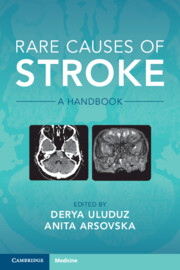Book contents
- Rare Causes of Stroke
- Rare Causes of Stroke
- Copyright page
- Contents
- Contributors
- Preface
- 1 Inflammatory Conditions
- Chapter 1.1 Isolated Vasculitis of the Central Nervous System
- Chapter 1.2 Primary Systemic Vasculitis
- Chapter 1.2 Chapter
- Chapter 1.3 Vasculitis Secondary to Systemic Disease
- 2 Infectious and Postinfectious Vasculitis
- 3 Hypercoagulable Causes of Stroke
- 4 Drug-Related Stroke
- 5 Hereditary and Genetic Causes of Stroke
- 6 Rare Causes of Cardioembolism
- 7 Vasospastic Conditions and Other Vasculopathies
- 8 Other Non-inflammatory Vasculopathies
- 9 Venous Occlusive Conditions
- 10 Bone Disorders and Stroke
- Index
- References
Chapter 1.2 - Chapter
from 1 - Inflammatory Conditions
Published online by Cambridge University Press: 06 October 2022
- Rare Causes of Stroke
- Rare Causes of Stroke
- Copyright page
- Contents
- Contributors
- Preface
- 1 Inflammatory Conditions
- Chapter 1.1 Isolated Vasculitis of the Central Nervous System
- Chapter 1.2 Primary Systemic Vasculitis
- Chapter 1.2 Chapter
- Chapter 1.3 Vasculitis Secondary to Systemic Disease
- 2 Infectious and Postinfectious Vasculitis
- 3 Hypercoagulable Causes of Stroke
- 4 Drug-Related Stroke
- 5 Hereditary and Genetic Causes of Stroke
- 6 Rare Causes of Cardioembolism
- 7 Vasospastic Conditions and Other Vasculopathies
- 8 Other Non-inflammatory Vasculopathies
- 9 Venous Occlusive Conditions
- 10 Bone Disorders and Stroke
- Index
- References
Summary
Susac syndrome (SS) is an occlusive arteriolar disease, leading to infarcts in the retina, cochlea and brain. The classic triad of the disease consists of subacute encephalopathy, visual disturbances and hearing loss. It is accepted as an autoimmune disease causing an endoteliopathy disturbing the microvasculature of the inner ear, retina and brain. The rarity and the clinical diversity of the disease can make cases challenging for clinicians to diagnose. There are no defined criteria for the diagnosis of SS. Diagnosis can be made based on the findings of brain magnetic resonance imaging (MRI), fundus fluorescein angiography (FFA) and audiometry. In brain MRI; small, roundish, multifocal T2-hyperintense lesions in the periventricular, subcortical and deep white matter areas with at least one of them centrally located in the corpus callosum (‘snowball’ appearance) can be observed. The callosal lesions are accepted as pathognomonic signs. There are no standardized treatment protocols. High doses of corticosteroids for 3–5 days and oral prednisolone treatment for the following 4 weeks are recommended in the acute phase. For patients who do not respond to this first line treatment, plasmapheresis or intravenous immunoglobulin can be chosen as an alternative option. If these treatment steps fail, more aggressive immunosuppression with agents of cylophosphamide and rituxumab can be considered. The usage of antiaggregant agents such as acetylsalicylic acid is also recommended for all patients with SS to decrease the risk of thrombosis
- Type
- Chapter
- Information
- Rare Causes of StrokeA Handbook, pp. 45 - 49Publisher: Cambridge University PressPrint publication year: 2022

